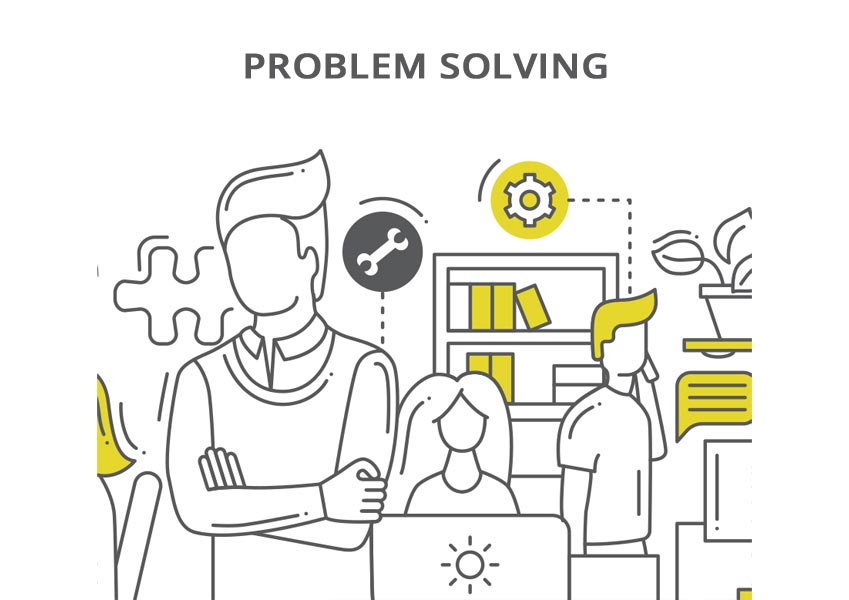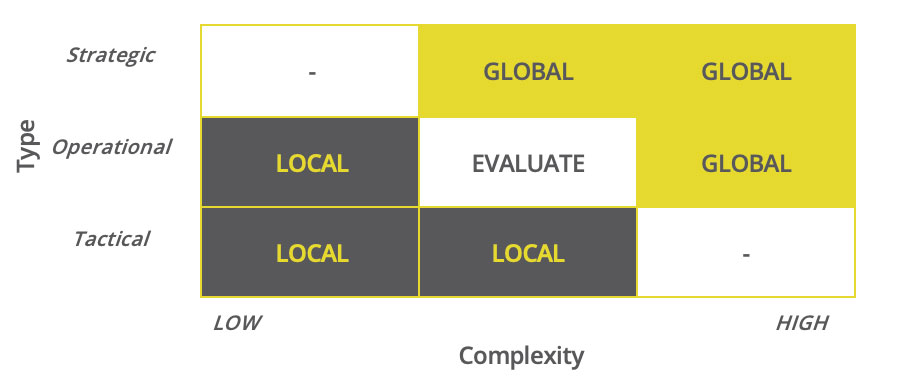
14 Nov Structured Problem Solving
Structured problem solving is an integral part in improving efficiency and economy, yet business support functions generally do not have the same focus on problem solving as perhaps technical functions. In addition, change management and transformation efforts rarely emphasize the importance of local problem solving to the appropriate degree.
So, what do we mean when we talk about structured problem solving in an organization? Problem solving takes place almost constantly within an organization, most of it unstructured i.e., it happens naturally without any kind of governance around it, be it formal or informal.
Think about the set of decisions that form part of an employee’s job description that the employee (or a team of employees) can take without consulting or seeking approval from anyone but oneself or the team. This type of problem solving can be considered unstructured, i.e., there is no governance or guiding principles, and is generally fine for solving problems at the process step level or those confined to the remit of an executor role. Structured problem solving differs from this in that there is defined governance, formal or informal, that drives and monitors problem solving activities, and a set of guiding principles that dictate how problems are solved.
At the Productivity Lab, we distinguish between two categories of structured problem solving:
- Global problem solving / Continuous Improvement (CI) uses advanced problem-solving philosophies, methodologies, and frameworks that for the most part have dedicated organization units and personnel, a formal governance, and are applied to major problems on a global scale
- Local problem solving uses simpler stand-alone problem-solving techniques, does not have dedicated organization units or personnel or formal governance, and are applied to operational and tactical problems, mainly on a regional or asset scale

Figure 1 below highlights the main differences between the two:
| CRITERIA | GLOBAL | LOCAL |
|---|---|---|
| Methodology / framework | Yes | No |
| Typical problem-solving techniques | Embedded in methodology / framework, e.g., 6 sigma, LEAN, Kaizen | Stand-alone techniques, 5 Why, Fishbone (Ishikawa), Flowcharts |
| Management support | Executive management support and involvement | Informal management support and encouragement |
| Governance | Formal, extensive | Informal |
| Dedicated organization units and personnel | In most cases, yes | No |
| Investment | Significant | Minimal, if any |
| Training | Extensive, typically involves external companies | Minimal, in most cases done internally |
| Time horizon for benefits | Medium / long | Small / medium |
| Data requirements | High quality | |
Figure 1: Global and Local problem solving
With regards to governance and guiding principles, the differences between global and local problem-solving is shown in Figure 2 below. As a reminder, problem-solving without any form of governance and guiding principles is what would be referred to as unstructured problem-solving.
| CRITERIA | GLOBAL | LOCAL |
|---|---|---|
| Governance | Formal, with set meetings and reporting, along with plans, targets and KPIs | Informal, relies on the use of existing meetings to drive and encourage |
| Guiding principles | Rigid, dependent on methodology / framework, for example 6 sigma uses Define, Measure, Analyze, Improve, Control (DMAIC) | Flexible, based on generic problem-solving frameworks such as A3 or 8D |
Figure 2: Governance and guiding principles
Why the need for structure? For problems that span over several business areas, it is recommended to have some sort of governance and guiding principles in place for solving problems, including the capture, and recording of problems. In this regard, it is worth noting that problems spanning across areas within a business function may also benefit from structured problem solving, particularly if they operate in silos.
Determining problem-solving focus
Considering when each of the two categories of structured problem solving are most effective, consider two dimensions: the type of problem and the complexity of the problem.
The type of problem can be classified according to risk and time-horizon for the impact of the problem-solving activities to be realized, following the start of an implementation:
- Strategic – high risk, typically recorded in an organization’s risk register, time for benefits from resolution to be realized is typically > 1 year
- Operational – medium risk, time for benefits from resolution to be realized < 1 year
- Tactical – low risk, time for benefits from resolution to be realized < 3 months
Complexity is a continuum from low to high, with the extremes identified by:
- Low – ‘single’ problem contained within one separate business area, can be solved by employees without additional consultations and approvals
- High – problem is generally made up of a combination of sub-problems, spanning several business areas and several geographical regions, cannot be solved without a significant number of consultations, and requires approvals from the highest level
Figure 3 below, indicates suitability of approaches depending on the type and complexity of the problem – to assess an organization on the matrix, take a view on where in the matrix most of the organization’s problems lie, and adopt the indicated approach. The approaches are not mutually exclusive, but it makes little sense implementing a full-scale six sigma program in an organization having mainly regional problems of low to medium complexity to solve, just as it makes little sense to attempt to solve global, strategic problems using local problem-solving techniques.

Figure 3: Problem solving matrix
It is worth noting some things in Figure 3:
- There are extremely few (if any) problems that can be classified as strategic, and having low complexity, so these types of problems are not considered
- There are extremely few (if any) problems that can be classified as tactical, and having high complexity, so these types of problems are not considered
- Problems classified as operational, and having medium complexity should be evaluated on a case-by-case basis, and would mainly lead to a complex approach, but could also in certain cases lead to a rapid approach
Most complex problem-solving activities are initiated based on a strategic need, and typically features in an organization’s strategy. Referring again to Figure 2, operational problems of high complexity could potentially be solved using a facilitator employing a complex problem-solving methodology, whereas for the strategic problems of medium and high complexity, this would most likely not be effective. For these latter problems, it would be recommended to implement a company-wide approach.
Local problem-solving
While many organizations are adopting global methodologies these days, few organizations are leveraging local problem-solving as much as they could and should, despite the potentially high returns from absolute minimal investment in money, time, and resources. Some of the benefits of local problem-solving include:

There is a significant amount of money tied up in smaller, local problems – the trick is to solve many of them in an efficient manner

The potential operational benefits to be realized from local problem-solving is staggering – the trick is to prioritize effectively for maximum effect

A constant focus on solving problems at the executor level will boost innovation – innovation at the executor level is crucial for operational excellence

Employees constantly solving problems will be more motivated – ticking a task off an action list is satisfactory, but solving a problem, even more sol
Implementing local problem solving is not necessarily easy, and it takes a lot out of line managers who must execute the informal governance. Consider the 7 steps below to get an organization started:
- Define informal governance, guiding principles and problem-solving techniques to use
- Develop necessary information and training materials
- Communicate to line managers intent and expectations
- Define business processes and responsible roles in scope (a RACI matrix helps)
- Communicate to roles in scope (be creative, sometimes a process walk-through can trigger some problem-solving right there), and identify training needs
- Conduct training where required
- Execute informal governance
Local problem-solving is very behavioral, and the success of a local problem-solving drive depends, as mentioned, very much on managers and their ability to in the initial stages being able to drive and encourage the problem-solving activity.
How we can help
At the Productivity Lab, we aim to make local problem-solving a part of most of our projects where operational and tactical problems are present and have experience from solving problems in oil and gas companies as well as in individual functions, including but not limited to, Supply Chain Management, HR, and Finance.
Alan Aastorp has built capabilities and delivered performance improvements for over 20 years, including engagements with some of the world’s largest companies, as well having professional qualifications in Supply Chain Management, Finance and HR. Alan can be reached at aastorp@productivity-lab.com.


